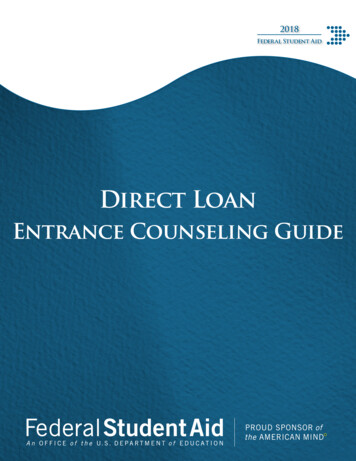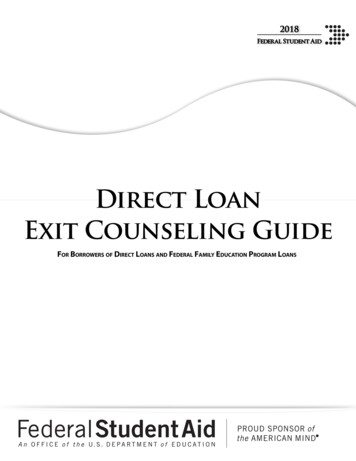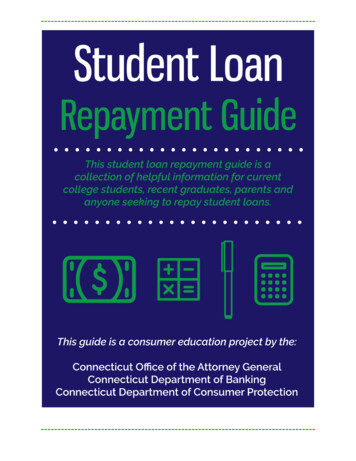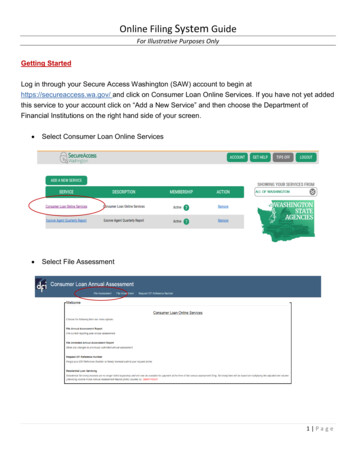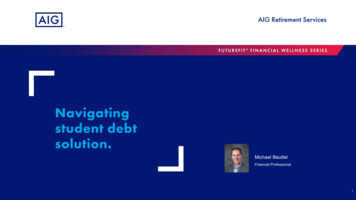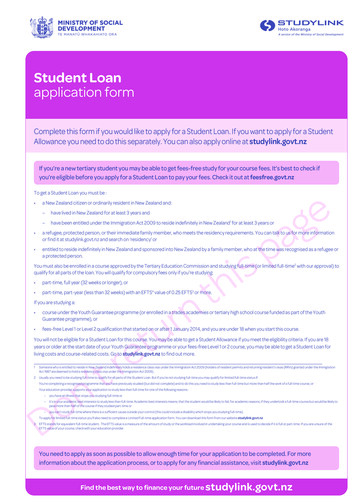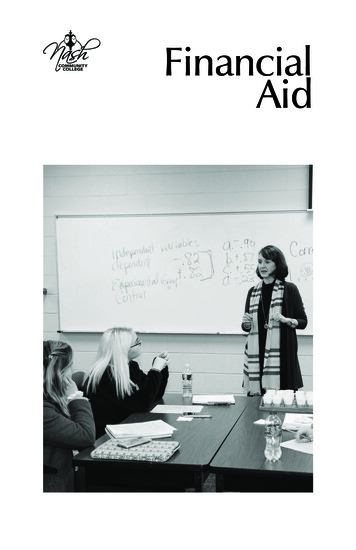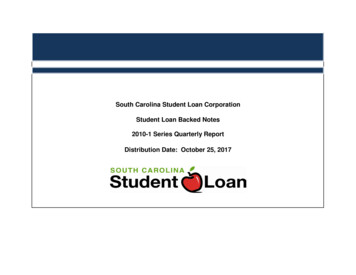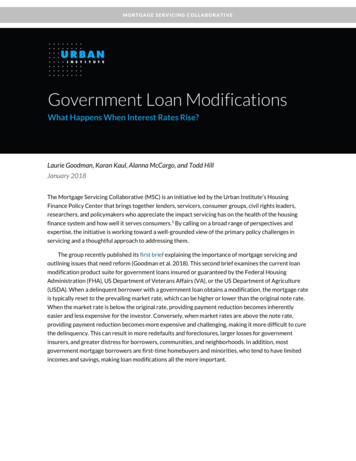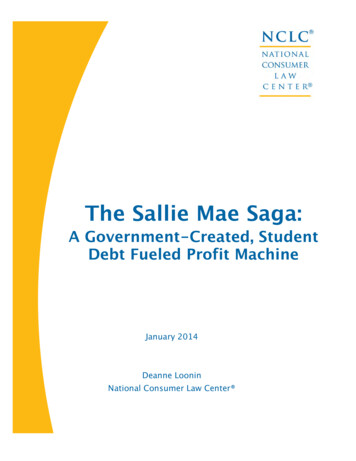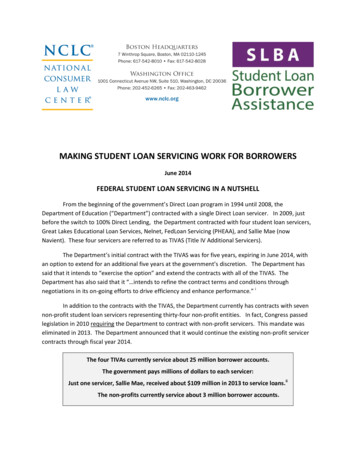
Transcription
MAKING STUDENT LOAN SERVICING WORK FOR BORROWERSJune 2014FEDERAL STUDENT LOAN SERVICING IN A NUTSHELLFrom the beginning of the government’s Direct Loan program in 1994 until 2008, theDepartment of Education (“Department”) contracted with a single Direct Loan servicer. In 2009, justbefore the switch to 100% Direct Lending, the Department contracted with four student loan servicers,Great Lakes Educational Loan Services, Nelnet, FedLoan Servicing (PHEAA), and Sallie Mae (nowNavient). These four servicers are referred to as TIVAS (Title IV Additional Servicers).The Department’s initial contract with the TIVAS was for five years, expiring in June 2014, withan option to extend for an additional five years at the government’s discretion. The Department hassaid that it intends to “exercise the option” and extend the contracts with all of the TIVAS. TheDepartment has also said that it “ intends to refine the contract terms and conditions throughnegotiations in its on-going efforts to drive efficiency and enhance performance.” iIn addition to the contracts with the TIVAS, the Department currently has contracts with sevennon-profit student loan servicers representing thirty-four non-profit entities. In fact, Congress passedlegislation in 2010 requiring the Department to contract with non-profit servicers. This mandate waseliminated in 2013. The Department announced that it would continue the existing non-profit servicercontracts through fiscal year 2014.The four TIVAs currently service about 25 million borrower accounts.The government pays millions of dollars to each servicer:Just one servicer, Sallie Mae, received about 109 million in 2013 to service loans.iiThe non-profits currently service about 3 million borrower accounts.
THE NEED FOR REFORM AND OVERSIGHTThe Department of Education is not providing sufficient oversight to ensure that allstudent loan borrowers receive quality service. iii For years, National Consumer Law Center staffmembers have sent examples of poor service and legal violations to the Department ofEducation and more recently to the Consumer Financial Protection Bureau (CFPB). Onlyrecently has the Department admitted to finding numerous problems with the performance ofservicers such as Sallie Mae. For example, the Department responded to a request forinformation from Senator Elizabeth Warren in December 2013 with a long list of “issues”identified by the Department in audits and reviews of Sallie Mae. These issues with Sallie Mae’sservicing of federal loans include defects in conversion to repayment, incomplete adjustmentsto borrower accounts when transferred from a previous servicer, and incorrect calculation ofincome for the income-based repayment program (IBR). However, the Department said thatcompliance issues have not risen to the level where “penalties were considered appropriate.” ivThe Department decided that these problems were not serious, but other federalagencies have come to different conclusions. For example, the FDIC and Department of Justiceannounced settlements with Sallie Mae in May 2014 based on allegations of a pattern andpractice of violating the Service Members Civil Relief Act and other consumer laws.QUALITY SERVICE AND PROTECTING BORROWERS AND TAXPAYERSThere are few laws specifically governing student loan servicer conduct. There are someprotections in the contracts that the Department signs with the servicers. However, borrowers rarelyknow about those rights. Even borrowers who find out about their rights have virtually no way toenforce them. To make matters worse, there is little or no government oversight.The system must work for borrowers, not just for private profit. At a minimum, borrowersmust have the following rights:1. Right to timely and accurate information about loan balances, payment histories and otherimportant account information.2. Right to timely and accurate information about affordable repayment, deferment, and otheroptions.3. Right to holistic counseling and information about the options that work best for borrowers.4. Right to switch servicers.5. Right to dispute errors and challenge abuses.6. Right to receive timely responses to appeals and inquiries.7. Right to obtain comprehensive performance information about all servicers.8. Right to relief for harm caused by servicer misconduct.
REFORM PRIORITIESDo Not Renew Current ContractsThere is ample evidence of non-compliance and legal violations among the current servicers.Yet the Department has already said that it will renew the contracts. Borrowers and taxpayers deservebetter than five more years of the same old system.Department leaders have said they cannot terminate the contracts among other reasonsbecause it would be too onerous to find new servicers. It will certainly be necessary to ensure a smoothtransition if servicers are removed from the government payroll, but this is not an excuse to let themlinger.In testimony before the U.S. Senate in March 2014, Federal Student Aid ChiefOperating Officer James Runcie said that the Department has considered thepotential dislocation of borrowers if they did not continue the TIVAS contracts.Chairman Harkin responded, “It sounded like your answer, Mr. Runcie, was thatthey’re too big to fail.” Senator Warren added: “I’m very concerned about reupping a multimillion –dollar contract with Sallie Mae, when Sallie Mae hasdemonstrated time and time again that it’s not following the rules.”vLimit the Number of Servicers and Create a Single Point of EntryThe goal of the system should be to provide quality service to borrowers. The currentsystem is not meeting this goal because, among other reasons, there are too many servicersand too much variation in service. As a result, many borrowers do not understand who isservicing their loans.Current servicers co-brand all correspondence, leading to confusion among borrowersas to why they are hearing from an unknown agency. This confusion has serious consequencesleading to communication breakdowns and sometimes to defaults.We agree with the Department that competition among a small group of highly qualifiedservicers will likely drive improved performance for borrowers and taxpayers. Limiting thenumber of servicers is important, but not enough. The Department must also eliminate cobranding and create a single point of entry for borrowers to communicate with servicers. Weagree with the Direct Loan Coalition that federal contractors servicing the loans should be“ invisible agents of the federal government with identical processes and policies.”viUnder this system, all borrowers will receive communications that are clearly from thegovernment, not from a private servicer or contractor that the borrower may or may not know
and may not even associate with student loans. Borrowers should be able to find out theidentities of servicers as necessary.Compensate Servicers Based on Comprehensive Default Prevention and Quality ServiceMetricsThe current performance metrics for the TIVAS that are used to allocate accounts are based oncustomer satisfaction, school and federal personnel surveys, and the number of borrowers and amountsof loans in default. The metrics for the non-profit servicers are more expansive, considering not only thetotal numbers of borrowers in default and the amounts in default, but also the percentage of borrowersin current repayment, 90 days delinquent and resolution of borrower accounts greater than 180 daysdelinquent.At a minimum, the Department should evaluate all servicers based on the additional defaultprevention statistics that currently apply only to non-profit servicers. Counting only the numbers ofborrowers in default is incomplete because it does not consider whether the servicers steeredborrowers to short-term options such as forbearances or other ways that servicers temporarily keepborrowers out of default to make their numbers look more attractive. This keeps the accounts flowingto the servicers, but too often at the expense of comprehensive, long-term relief for borrowers.Provide Public Information about Servicer PerformancePublic information should include detailed information about the current performance metricsand other investigations and evaluations of servicer performance.Conduct Rigorous Oversight and Penalize Servicers that Do Not PerformThe Department has authority to terminate contracts or otherwise penalize servicers thatviolate program requirements. Under existing authority, in addition to terminating contracts, theDepartment can: Choose not to assign further accounts or transfer existing accounts to other servicers based onnon-compliance with the contract,Unilaterally shift borrowers to other servicers,Decide not to reimburse servicers for loans that were not serviced in compliance with thecontracts, andTerminate contracts if conflicts of interest arise or if necessary to avoid the appearance of aconflict of interest.The Department must use these tools to protect borrowers and taxpayers. Otherregulators must be part of the solution too. The CFPB’s announcement in December 2013 thatit will begin supervising large student loan servicers is a promising sign for borrowers.vii TheCFPB can help fill the gaps caused by a long history of lax federal oversight. The CFPB, theDepartment of Education and other agencies must work together to ensure that servicers are
doing their jobs properly. State Attorney General Offices also have an important role inprotecting consumers in their states.Solicit Borrower InputThe Department of Education has severely restricted access to contracts and importantservicing instructions. We fear that the Department of Education is moving toward a model inwhich it justifies withholding basic information about private servicers because of supposedproprietary contract arrangements. For example, the Department has said that it is in the finalstages of developing revised performance metrics and other reforms. Yet this appears to be a closedprocess.Relying on private contracts may work well if the Department is seeking to avoidaccountability, but it does not work best for borrowers and taxpayers. Schools may be profitingas tuition continues to rise and private servicers and collectors may be profiting due toborrower misfortune, but we should not be growing our student loan system on the backs ofdefaulted borrowers or measuring success by private profit rather than student success.We can and must do better for student borrowers and taxpayers.iU.S. Department of Education, Letter to Chairman John Kline, Committee on Education and the Workforce, U.S.House of Representatives (March 31, 2014).iiShahien Nasiripour and Zach Carter, “How Arne Duncan is Undercutting Senate Democrats on Student LoanReform”, Huffington Post (May 7, 2014).iiiSee, e.g., U.S. Department of Education, Office of Inspector General, “Federal Student Aid’s Award andAdministration of the Title IV Additional Servicers Contracts”, Final Audit Report ED-OIG/A02L0006 (August 2013).ivSenator Warren’s letter and the Department of Education’s response are available in attachments to NCLC’sreport: “The Sallie Mae Saga: A Government-Created, Student Debt Fueled Profit Machine” (January 2014).vQuoted in Michael Stratford, “Ed Dept. Defends Loan Servicing”, InsideHigher Ed (March 28, 2014).viSee, e.g, Statement of Nancy Hoover, Director Financial Aid, Denison University, before the U.S. Senate BankingSubcommittee on Financial Institutions and Consumer Protection (June 4, 2014).viiConsumer Financial Protection Bureau, “CFPB to Oversee Nonbank Student Loan Servicers” (Dec. 3,2013).
MAKING STUDENT LOAN SERVICING WORK FOR BORROWERS June 2014 . ("Department") contracted with a single Direct Loan servicer. In 2009, just before the switch to 100% Direct Lending, the Department contracted with four student loan servicers, Great Lakes Educational Loan Services, Nelnet, FedLoan Servicing (PHEAA), and Sallie Mae (now
